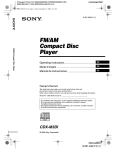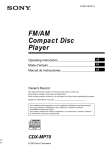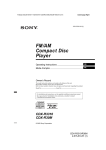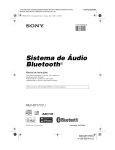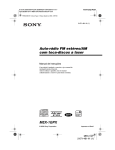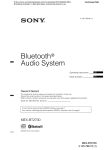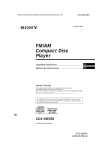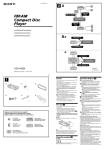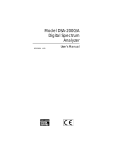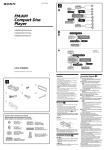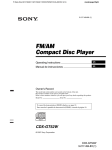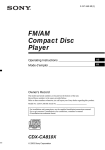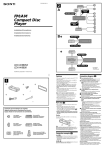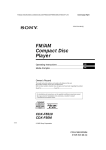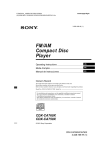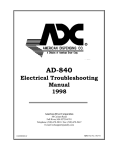Download Sony CDX-MP70 User's Manual
Transcript
masterpage:Right 00US+00COV-U.book Page 1 Friday, December 7, 2001 12:24 PM 3-239-019-21 (1) FM/AM Compact Disc Player Operating Instructions US Mode d’emploi FR Manual de instrucciones ES Owner’s Record The model and serial numbers are located on the bottom of the unit. Record these numbers in the space provided below. Refer to these numbers whenever you call upon your Sony dealer regarding this product. Model No. CDX-MP70 Serial No. For installation and connections, see the supplied installation/connections manual. En ce qui concerne l’installation et les connexions, consulter le manuel d’installation/raccordement fourni. Para obtener información sobre la instalación y las conexiones, consulte el manual de instalación/conexiones suministrado. CDX-MP70 © 2002 Sony Corporation CDX-MP70 3-239-019-21 (1) masterpage:Left 01US01INT-U.fm 00US+00COV-U.book Page 2 Friday, December 7, 2001 12:24 PM Warning Welcome ! This equipment has been tested and found to comply with the limits for a Class B digital device, pursuant to Part 15 of the FCC Rules. These limits are designed to provide reasonable protection against harmful interference in a residential installation. This equipment generates, uses, and can radiate radio frequency energy and, if not installed and used in accordance with the instructions, may cause harmful interference to radio communications. However, there is no guarantee that interference will not occur in a particular installation. If this equipment does cause harmful interference to radio or television reception, which can be determined by turning the equipment off and on, the user is encouraged to try to correct the interference by one or more of the following measures: – Reorient or relocate the receiving antenna. – Increase the separation between the equipment and receiver. – Connect the equipment into an outlet on a circuit different from that to which the receiver is connected. – Consult the dealer or an experienced radio/TV technician for help. Thank you for purchasing this Sony Compact Disc Player. You can enjoy its various features even more with: • MP3 file playback. • Non-finalized CD-R/CD-RW disc playback capability (page 7). • Discs recorded in Multi Session (CD-Extra, Mixed CD, etc.) can be played, depending on the recording method (page 8). • Optional CD/MD units (both changers and players)*1. • ID3 tag*2 version 1 information (displayed when an MP3 file is played). • CD TEXT information (displayed when a CD TEXT disc*3 is played). • 7 color display (you can select from a range of 7 colors). • Supplied controller accessory Card remote commander RM-X112 • Optional controller accessory Wireless rotary commander RM-X5S You are cautioned that any changes or modifications not expressly approved in this manual could void your authority to operate this equipment. CAUTION The use of optical instruments with this product will increase eye hazard. *1 This unit works with Sony products only. *2 ID3 tag is an MP3 file that contains information about album name, artist name, track name, etc. *3 A CD TEXT disc is an audio CD that includes information such as the disc name, artist name, and track names. This information is recorded on the disc. The “XM Ready” logo indicates that this product will control a Sony XM tuner module (sold separately). Please see your nearest authorized Sony dealer for details on the XM tuner module. For instructions on XM tuner operation, please refer to the XM tuner module’s included instruction manual. 2 CDX-MP70 3-239-019-21 (1) masterpage:Right 00US+00COV-UTOC.fm 00US+00COV-U.book Page 3 Friday, December 7, 2001 12:24 PM Table of Contents Location of controls. . . . . . . . . . . . . . . . . . . . 4 Precautions . . . . . . . . . . . . . . . . . . . . . . . . . . 6 Notes on discs . . . . . . . . . . . . . . . . . . . . . . . . 7 About MP3 files . . . . . . . . . . . . . . . . . . . . . . 8 Getting Started Resetting the unit . . . . . . . . . . . . . . . . . . . . . . 9 Detaching the front panel . . . . . . . . . . . . . . 10 Setting the clock . . . . . . . . . . . . . . . . . . . . . 11 CD Player CD/MD Unit (optional) Playing a disc. . . . . . . . . . . . . . . . . . . . . . . . 11 Display items . . . . . . . . . . . . . . . . . . . . . . . . 13 Playing tracks repeatedly — Repeat Play . . . . . . . . . . . . . . . . . . . . 13 Playing tracks in random order — Shuffle Play . . . . . . . . . . . . . . . . . . . . 13 Labeling a CD — Disc Memo*. . . . . . . . . . . . . . . . . . . . 14 Locating a disc by name — List-up* . . . . . . . . . . . . . . . . . . . . . . . 15 * Functions available with optional CD/MD unit Other Functions Using the rotary commander. . . . . . . . . . . . Adjusting the sound characteristics . . . . . . Quickly attenuating the sound . . . . . . . . . . Changing the sound and display settings — Menu . . . . . . . . . . . . . . . . . . . . . . . . . Setting the Dynamic Soundstage Organizer (DSO) . . . . . . . . . . . . . . . . . . . . . . . . . . . Setting the equalizer . . . . . . . . . . . . . . . . . . Adjusting the front and rear volume . . . . . . Adjusting the volume of the subwoofer(s). . . . . . . . . . . . . . . . . . . . . . Selecting the spectrum analyzer . . . . . . . . . Labeling a Demo display — Appearing Characters . . . . . . . . . . . . Connecting auxiliary audio equipment . . . . 19 21 21 21 22 23 24 24 25 25 26 Additional Information Maintenance . . . . . . . . . . . . . . . . . . . . . . . . Removing the unit. . . . . . . . . . . . . . . . . . . . Specifications . . . . . . . . . . . . . . . . . . . . . . . Troubleshooting . . . . . . . . . . . . . . . . . . . . . Error displays/Messages . . . . . . . . . . . . . . . 27 28 29 30 31 Radio Storing stations automatically — Best Tuning Memory (BTM). . . . . . . 16 Receiving the stored stations . . . . . . . . . . . . 16 Storing only desired stations . . . . . . . . . . . . 17 Storing station names — Station Memo. . . . . . . . . . . . . . . . . . . 17 Tuning in a station through a list — List-up . . . . . . . . . . . . . . . . . . . . . . . . 18 3 CDX-MP70 3-239-019-21 (1) masterpage:Left 01US02CD-U.fm 00US+00COV-U.book Page 4 Friday, December 7, 2001 12:24 PM Location of controls CDX-MP70 Behind the front panel 4 CDX-MP70 3-239-019-21 (1) masterpage:Right 01US02CD-U.fm 01US02CD-U.fm Page 5 Friday, December 7, 2001 1:14 PM Refer to the pages listed for details. a VOL (volume) control dial/SOUND button Rotate to: – Adjust the volume. – Adjust the sound setting. Press to: – Select the sound setting. b SOURCE button To select the source. c MODE button To change the operation. d DSPL button 13, 14, 26 e Display window f LIST button 12, 14, 15, 15 17, 18 g MENU button To display the menus. h Z (eject) button 11, 12, 12 i RELEASE button 10 j OFF (Stop/Power off) button* 10, 12, 25, 26 k Receptor for the card remote commander and wireless rotary commander l REP button 13 m SHUF button 13 n m/M (SEEK –/+) buttons To fast-forward, reverse a track, tune in stations automatically, find a station manually, and select a setting. o ./> (–/+) control dial Rotate to: – Receive preset stations. – Skip tracks. – Select a menu. Press to: – Enter a setting. p OPEN/CLOSE button 10, 11 q N (play) button 11 r RESET button 9 * Warning when installing in a car without an ACC (accessory) position on the ignition switch After turning off the ignition, be sure to press (OFF) on the unit for 2 seconds to turn off the clock display. Otherwise, the clock display does not turn off and causes battery drain. Card remote commander RM-X112 SCRL DSPL REP SHUF 1 2 3 4 5 6 DSO MODE EQ7 MENU DISC + LIST SEEK– SOUN D OFF SOURCE DISC – + SEEK+ R ENTE ATT VOL – The corresponding buttons of the card remote commander control the same functions as those on this unit. a b c d e f g h i j k l m n o p SCRL button DSPL button Number buttons DSO button MENU button SOURCE button SEEK (</,) buttons SOUND button OFF button VOL (+/–) buttons MODE button EQ7 button LIST button DISC/ALBUM (M/m) buttons ENTER button ATT button continue to next page t 5 CDX-MP70 3-239-019-21 (1) masterpage:Left 01US02CD-U.fm 01US02CD-U.fm Page 6 Saturday, December 15, 2001 7:23 PM Note If the unit is turned off by pressing (OFF) for 2 seconds, it cannot be operated with the card remote commander unless (SOURCE) on the unit is pressed to reactivate the unit first. Tip See “Replacing the lithium battery” on page 27 for details on how to replace the batteries. Selecting a disc and album with the card remote commander Precautions • If your car was parked in direct sunlight, allow the unit to cool off before operating it. • Power antennas will extend automatically while the unit is operating. • Do not use the CUSTOM FILE feature while driving, or perform any other function which could divert your attention from the road. Disc and album can be skipped using the DISC/ ALBUM (M/m) buttons on the card remote commander. If you have any questions or problems concerning your unit that are not covered in this manual, please consult your nearest Sony dealer. (With this unit) Moisture condensation To Press Skip albums* M or m [once for each – Album selection album] To continuously skip albums, press and hold either button. (With optional unit) To Press Skip discs – Disc selection M or m [once for each disc] To continuously skip discs, press once and press again within 1 second (and hold) either button. On a rainy day or in a very damp area, moisture condensation may occur inside the lenses and display of the unit. Should this occur, the unit will not operate properly. In such a case, remove the disc and wait for about an hour until the moisture has evaporated. To maintain high sound quality Be careful not to splash juice or other soft drinks onto the unit or discs. Notes on CD lens • Do not touch the lens in the disc tray. • Do not use a commercially available lens cleaner. Skip albums* M or m [hold for a moment] – Album selection and release To continuously skip albums, press (and hold) within 1 second of first releasing the button. * Available only when an MP3 file is played. Skipping tracks continuously Press once either SEEK/AMS (< or ,) button on the card remote commander, then press again within 1 second and hold. 6 CDX-MP70 3-239-019-21 (1) masterpage:Right 01US02CD-U.fm 00US+00COV-U.book Page 7 Friday, December 7, 2001 12:24 PM Notes on discs Notes on CD-Rs (recordable CDs)/CDRWs (rewritable CDs) This unit can play the following discs: • To keep the disc clean, do not touch the surface. Handle the disc by its edge. • Keep your discs in their cases or disc magazines when not in use. Do not subject the discs to heat/high temperature. Avoid leaving them in parked cars or on dashboards/rear trays. Type of discs Label on the disc Audio CD MP3 files • Do not attach labels, or use discs with sticky ink/residue. Such discs may stop spinning when used, causing a malfunction, or may ruin the disc. • Some CD-Rs/CD-RWs (depending on the equipment used for its recording or the condition of the disc) may not play on this unit. • You can play a CD-R/CD-RW that is not finalized*. • You can play MP3 files recorded on CDROMs, CD-Rs, and CD-RWs. * A process necessary for a recorded CD-R/CD-RW disc to be played on the audio CD player. • Do not use any discs with labels or stickers attached as this may cause inability to read audio data correctly (e.g., playback skipping, or no playback) due to heat shrinking of a sticker or label causing a disc to warp. • Discs with non-standard shapes (e.g., heart, square, star) cannot be played on this unit. Attempting to do so may damage the unit. Do not use such discs. • Before playing, clean discs with a commercially available cleaning cloth. Wipe each disc from the center out. Do not use solvents such as benzine, thinner, commercially available cleaners, or antistatic spray intended for analog discs. 7 CDX-MP70 3-239-019-21 (1) masterpage:Left 01US02CD-U.fm 00US+00COV-U.book Page 8 Friday, December 7, 2001 12:24 PM About MP3 files MP3 (MPEG 1 Audio Layer-3) is a standard technology and format for compressing a sound sequence. The file is compressed to about 1/10 of its original size. Sounds outside the range of human hearing are compressed while the sounds we can hear are not compressed. Notes on discs You can play MP3 files recorded on CD-ROMs, CD-Rs, and CD-RWs. The disc must be in the ISO 9660*1 level 1 or level 2 format, or Joliet or Romeo in the expansion format. You can use a disc recorded in Multi Session*2. *1 ISO 9660 Format The most common international standard for the logical format of files and folders on a CD-ROM. There are several specification levels. In Level 1, file names must be in the 8.3 format (no more than 8 characters in the name, no more than 3 characters in the extension “.MP3”) and in capital letters. Folder names can be no longer than 8 characters. There can be no more than 8 nested folder levels. Level 2 specifications allow file names up to 31 characters long. Each folder can have up to 8 trees. For Joliet or Romeo in the expansion format, make sure of the contents of the writing software, etc. Notes • With formats other than ISO 9660 level 1 and level 2, folder names or file names may not be displayed correctly. • When naming, be sure to add the file extension “.MP3” to the file name. • If you put the extension “.MP3” to a file other than MP3, the unit cannot recognize the file properly and will generate random noise that could damage your speakers. • The following discs take a longer time to start playback. – a disc recorded with complicated tree structure. – a disc recorded in Multi Session. – a disc to which data can be added (non-finalized disc). Cautions when playing a disc that is recorded in Multi Session • When the first track of the first session is audio CD data: Non-audio CD data information (track number, time, etc.) is displayed with no sound. • When the first track of the first session is not audio CD data: – If an MP3 file is in the disc, only MP3 file(s) play back and other data is skipped. (Audio CD data is not recognized.) – If no MP3 file is in the disc, “NO Music” is displayed and nothing is played back. (Audio CD data is not recognized.) *2 Multi Session This is a recording method that enables adding of data using the Track-At-Once method. Conventional CDs begin at a CD control area called the Lead-in and end at an area called Lead-out. A Multi Session CD is a CD having multiple sessions, with each segment from Lead-in to Lead-out regarded as a single session. CD-Extra: The format which records audio (audio CD data) as tracks on session 1, and records data as tracks on session 2. Mixed CD: In this format, data is recorded as track 1, and audio (audio CD data) is recorded as track 2. 8 CDX-MP70 3-239-019-21 (1) masterpage:Right 01US02CD-U.fm 01US02CD-U.fm Page 9 Saturday, December 15, 2001 7:26 PM The playback order of the MP3 files The playback order of the folders and files is as follows: Getting Started Folder (album) 1 Resetting the unit 1 MP3 file (track) Before operating the unit for the first time, or after replacing the car battery or changing the connections, you must reset the unit. Remove the front panel and press the RESET button with a pointed object, such as a ball-point pen. 2 2 3 3 4 5 4 5 6 RESET button Note Pressing the RESET button will erase the clock setting and some stored contents. 6 7 7 8 8 9 Tree 1 (root) Tree 2 Tree 3 Tree 4 Tree 5 Notes • A folder that does not include an MP3 file is skipped. • Maximum folder number: 255 (including root folder and empty folders) • The maximum number of MP3 files and folders that can be contained in a disc: 512 When a file/folder name contains many characters, this number may become less than 512. • The maximum number of trees which can be played is 8. Tip To specify a desired playback order, before the folder or file name, input the order by number (e.g., “01,” “02”), then record contents onto a disc. (The order differs depending on the writing software.) 9 CDX-MP70 3-239-019-21 (1) masterpage:Left 01US02CD-U.fm 00US+00COV-U.book Page 10 Friday, December 7, 2001 12:24 PM Detaching the front panel You can detach the front panel of this unit to protect the unit from being stolen. Attaching the front panel Attach part A of the front panel to part B of the unit as illustrated and push the left side into position until it clicks. Caution alarm If you turn the ignition switch to the OFF position without removing the front panel, the caution alarm will beep for a few seconds. 1 Press (OFF)*. CD/MD playback or radio reception stops (the key illumination and display remain on). A B * If your car has no ACC position on the ignition switch, be sure to turn the unit off by pressing (OFF) for 2 seconds to avoid car battery drain. 2 Press (RELEASE) to open up the front panel and pull it off towards you. Notes • Do not put anything on the inner surface of the front panel. • Do not detach the front panel during the eject operation. If the front panel is detached during eject, operation will stop. To eject the disc when you do not have the front panel attached, press (OPEN/CLOSE) inside the unit through hole C with a pointed object, such as a ballpoint pen. (RELEASE) Notes • If you detach the panel while the unit is still turned on, the power will turn off automatically to prevent the speakers from being damaged. • Do not drop or put excessive pressure on the front panel and its display window. • Close the front panel before you detach it. • Do not subject the front panel to heat/high temperature or moisture. Avoid leaving it in parked cars or on dashboards/rear trays. C Tip When carrying the front panel with you, use the supplied front panel case. 10 CDX-MP70 3-239-019-21 (1) masterpage:Right 01US02CD-U.fm 00US+00COV-U.book Page 11 Friday, December 7, 2001 12:24 PM Setting the clock The clock uses a 12-hour digital indication. CD Player CD/MD Unit (optional) Example: To set the clock to 10:08 In addition to playing a CD with this unit, you can also control external CD/MD units. ./> control dial 1 Press (MENU), then rotate the ./> control dial until “Clock” appears. Note If you connect an optional CD unit with the CD TEXT function, the CD TEXT information will appear in the display when you play a CD TEXT disc. Playing a disc (With this unit) 1 Press Z. The disc compartment slides out. 2 Place a disc on the disc tray with the label side up. Insert the disc until it clicks. 3 Press N. The disc compartment closes and playback starts. 1 Press the ./> control dial. The hour indication flashes. 2 Rotate the ./> control dial to set the hour. 3 Press the M+ button. The minute indication flashes. 4 Rotate the ./> control dial to set the minute. 2 Press the ./> control dial. The clock starts. After the clock setting is completed, the display returns to normal play mode. Tip When D.Info mode is set to on, the time is always displayed (page 21). If a disc is already inserted, press (SOURCE) repeatedly until “CD” appears in the display, and playback starts. (If you press (OPEN/CLOSE), the disc compartment closes but playback does not start.) Notes • Do not place more than 1 disc on the disc tray. • The disc compartment closes automatically after 30 seconds. continue to next page t 11 CDX-MP70 3-239-019-21 (1) masterpage:Left 01US02CD-U.fm 00US+00COV-U.book Page 12 Friday, December 7, 2001 12:24 PM (With optional unit) ./> control dial 1 Press (SOURCE) repeatedly to select “CD” or “MD (MS*).” 2 Press (MODE) repeatedly until the desired unit appears. Playback starts. To Do this * MS: MG Memory Stick System-up Player MGS-X1. Stop playback Press (OFF). Cautions when connecting MGS-X1 and MD unit(s) This unit recognizes MGS-X1 as an MD unit. • When you want to play MGS-X1, press (SOURCE) to select “MS” or “MD.” If “MS” appears in the source display, MGS-X1 starts to play. If “MD” appears in the source display, press (MODE) to select “MS,” to start playback. • When you want to play an MD unit, press (SOURCE) to select “MD” or “MS.” If your desired MD unit appears in the source display, it starts to play. If “MS” or another MD unit appears in the source display, press (MODE) to select your desired MD unit, to start playback. Eject the disc Press Z. Skip tracks – Automatic Music Sensor Rotate the ./> control dial. Fast-forward/ reverse – Manual Search Press and hold the –m or M+ button, and release at the desired point. Skip albums* Press (LIST), then rotate the – Album selection ./> control dial. * Available only when an MP3 file is played. To remove the disc, press down the center spindle, and lift up the edge of the disc from the relief in the disc tray. Locating a disc — Disc selection See “Locating a disc by name” on page 15. Notes • Depending on the recording method used on the disc, it may take a minute or more before playing the first track. • Depending on the condition of the disc, it may not play back (page 7, 8). • Such discs should be finalized. • While the first/last track on the disc is playing, if the ./> control dial is rotated, playback skips to the last/first track of the disc. • When the last track on the disc is over, playback restarts from the first track of the disc. • With optional unit connected, playback of the same source will continue on to the optional CD/MD unit. • There is a delay for a few seconds after pressing Z before the disc tray is ejected, after reading the data in the disc.) 12 CDX-MP70 3-239-019-21 (1) masterpage:Right 01US02CD-U.fm 01US02CD-U.fm Page 13 Saturday, December 15, 2001 7:28 PM Display items Playing tracks repeatedly When the disc/album/track changes, any prerecorded title*1 of the new disc/album/track is automatically displayed (if the Auto Scroll function is set to “on,” names exceeding 9 characters will be scrolled (page 21)). DISC/ALBUM number TRACK number Elapsed playing time — Repeat Play The disc in the main unit will repeat a track, the entire album, or the entire disc when it reaches the end. For repeat play, you can select: • REP TRACK — to repeat a track. • REP ALBUM*1 — to repeat an album. • REP DISC*2 — to repeat a disc. *1 Available only for MP3 files. *2 Available only when one or more optional CD/MD units are connected. During playback, press (REP) repeatedly until the desired setting appears in the display. Repeat Play starts. Displayable items • Disc name*1/artist name*2 • Album (folder) name*3 • Track (file) name*1 • ID3 tag*3 To Press Switch display item (DSPL) Scroll display item (DSPL) for 2 seconds *1 When pressing (DSPL), “NO D.Name” or “NO T.Name” indicates that there is no Disc Memo (page 14) or prerecorded name to display. *2 Only for CD TEXT discs with the artist name. *3 Only for MP3 files. Only track name/artist name/album name in ID3 tag is displayed. When pressing (DSPL), “NO ID3 Tag” indicates that there is no ID3 tag to display. Notes • Some characters cannot be displayed. • For some CD TEXT discs with very many characters, information may not scroll. • This unit cannot display the artist name for each track of a CD TEXT disc. Notes on MP3 • ID3 tag applies only to version 1. • The ID3 tag character codes comply with ASCII and ISO 8859-1 standards. Joliet format discs can only be displayed in ASCII. Incompatible characters will be displayed as “ *.” • In the following cases, elapsed playing time may not be displayed accurately. – when an MP3 file of VBR (variable bit rate) is played. – during fast-forward/reverse. Tip When Auto scroll is set to off and the disc/album/track name is changed, the disc/album/track name does not scroll. To return to normal play mode, select “REP off.” Playing tracks in random order — Shuffle Play You can select: • SHUF ALBUM*1 — to play the tracks in the current album in random order. • SHUF DISC — to play the tracks on the current disc in random order. • SHUF CHNGR*2 — to play the tracks in the current optional CD (MD) unit in random order. • SHUF ALL*3 — to play all the tracks in all the connected CD (MD) units (including this unit) in random order. *1 Available only for MP3 files. *2 Available only when one or more optional CD (MD) units are connected. *3 Available only when one or more optional CD units, or two or more optional MD units are connected. During playback, press (SHUF) repeatedly until the desired setting appears in the display. Shuffle Play starts. To return to normal play mode, select “SHUF off.” Note “SHUF ALL” will not shuffle tracks between CD units and MD units. 13 CDX-MP70 3-239-019-21 (1) masterpage:Left 01US02CD-U.fm 00US+00COV-U.book Page 14 Friday, December 7, 2001 12:24 PM 4 Labeling a CD Enter the characters. 1 Rotate the ./> control dial to select the desired character. — Disc Memo (For a CD unit with the CUSTOM FILE function) A y B y C ... y 0 y 1 y 2 ... y ... y * y A +y–y You can label each disc with a custom name (Disc Memo). You can enter up to 8 characters for a disc. If you label a CD, you can locate the disc by name (page 15). * * (blank space) 2 Press the M+ button after locating the desired character. Caution Do not use the CUSTOM FILE feature while driving, or perform any other function which could divert your attention from the road. If you press the –m button, you can move back to the left. ./> control dial 3 Repeat steps 1 and 2 to enter the entire name. 5 1 Start playing the disc you want to label in a CD unit with the CUSTOM FILE function. 2 Press (MENU), then rotate the ./> control dial until “Name Edit” appears. 3 Press the ./> control dial. To return to normal CD play mode, press the ./> control dial. Tips • Simply overwrite or enter “ ” to correct or erase a name. • There is another way to start labeling a CD: Press (LIST) for 2 seconds instead of performing steps 2 and 3. You can also complete the operation by pressing (LIST) for 2 seconds instead of step 5. • You can label CDs on a unit without the CUSTOM FILE function if that unit is connected along with a CD unit that has the function. The Disc Memo will be stored in the memory of the CD unit with the CUSTOM FILE function. Note Repeat/shuffle play is suspended until the Name Edit is complete. The unit will repeat the disc during the labeling procedure. Viewing the Disc Memo As a display item, the Disc Memo always takes priority over any original CD TEXT information. To Press View (DSPL) during CD/CD TEXT disc playback Tip To find out about other items that can be displayed, see page 13. 14 CDX-MP70 3-239-019-21 (1) masterpage:Right 01US02CD-U.fm 00US+00COV-U.book Page 15 Friday, December 7, 2001 12:24 PM Erasing the Disc Memo 1 Press (SOURCE) repeatedly to select “CD.” 2 Press (MODE) repeatedly to select the CD unit storing the Disc Memo. 3 Press (MENU), then rotate the ./> control dial until “Name Del” appears. 4 Press the ./> control dial. The stored names will appear. 5 Rotate the ./> control dial to select the disc name you want to erase. 6 Press the ./> control dial for 2 seconds. The name is erased. Repeat steps 5 and 6 if you want to erase other names. 7 Press (MENU) twice. The unit returns to normal CD play mode. Locating a disc by name — List-up (For a CD unit with the CD TEXT/ CUSTOM FILE function, or an MD unit) You can use this function for discs that have been assigned custom names*1 or for CD TEXT discs*2. *1 Locating a disc by its custom name: when you assign a name for a CD (page 14) or an MD. *2 Locating discs by the CD TEXT information: when you play a CD TEXT disc on a CD unit with the CD TEXT function. ./> control dial 1 Press (LIST). The name assigned to the current disc appears in the display. 2 Rotate the ./> control dial until you find the desired disc. 3 Press the ./> control dial to play the disc. Notes • When the Disc Memo for a CD TEXT disc is erased, the original CD TEXT information is displayed. • If you cannot find the Disc Memo you want to erase, try selecting a different CD unit in step 2. Note In the case of CD TEXT discs and MDs, some letters cannot be displayed. Locating an album or track by name When a name is assigned to an album*3, or track*4, you can locate it by name. 1 Press (LIST) repeatedly until album/ track name appears in the display. Each time you press (LIST), the display will change in order of disc name, album name, and track name. After 5 seconds, the display returns to the normal playback mode. 2 Rotate the ./> control dial until you find the desired album/track. Playback starts. *3 Available only for MP3 files. *4 Available only for MP3 files, CD TEXT disc, and MD. 15 CDX-MP70 3-239-019-21 (1) masterpage:Left 01US02CD-U.fm 00US+00COV-U.book Page 16 Friday, December 7, 2001 12:24 PM Receiving the stored stations Radio The unit can store up to 6 stations per band (FM1, FM2, FM3, AM1, and AM2). ./> control dial Caution When tuning in stations while driving, use Best Tuning Memory to prevent accidents. 1 Storing stations automatically Press (SOURCE) repeatedly to select the radio. 2 Press (MODE) repeatedly to select the band. — Best Tuning Memory (BTM) 3 Rotate the ./> control dial until you find the desired station. The unit selects the stations with the strongest signals within the selected band, and stores them in the order of their frequency. Tip Press the number button ((1) to (6)) on the card remote commander to select the stored station directly. If preset tuning does not work ./> control dial 1 Press (SOURCE) repeatedly to select the radio. 2 Press (MODE) repeatedly to select the band. 3 Press (MENU), then rotate the ./> control dial until “BTM” appears. 4 Press the ./> control dial. A beep sounds when the setting is stored. Notes • If only a few stations can be received due to weak signals, some stored numbers will retain their former settings. • When a number is indicated in the display, the unit starts storing stations from the one currently displayed. Press the –m or M+ button to search for the station (automatic tuning). Scanning stops when the unit receives a station. Repeat until the desired station is received. Tips • If automatic tuning stops too frequently, turn on the Local Seek to limit seek to stations with stronger signals (see “Changing the sound and display settings” on page 21). • If you know the frequency of the station you want to listen to, press and hold the –m or M+ button to locate the approximate frequency, then press the –m or M+ button repeatedly to fine adjust to the desired frequency (manual tuning). If FM stereo reception is poor Select monaural reception mode (see “Changing the sound and display settings” on page 21). The sound improves, but becomes monaural (“ST” disappears). Note If interference occurs, this unit will automatically narrow the reception frequency to eliminate noise (IF Auto function). In such cases, some FM stereo broadcasts may become monaural while in the stereo reception mode. 16 Tips • To always hear FM stereo broadcasts in stereo, you can change the IF Auto setting and widen the frequency signal reception (see “Changing the sound and display settings” on page 21). Note that some interference may occur in this setting. • If FM broadcasts are difficult to hear, set DSO to off (page 22). CDX-MP70 3-239-019-21 (1) masterpage:Right 01US02CD-U.fm 00US+00COV-U.book Page 17 Friday, December 7, 2001 12:24 PM Storing only desired stations You can manually preset desired stations. ./> control dial Storing station names — Station Memo You can assign a name to each radio station and store it in memory. The name of the station currently tuned in appears in the display. You can assign a name using up to 8 characters for a station. Storing the station names 1 Press (SOURCE) repeatedly to select the radio. 2 Press (MODE) repeatedly to select the band. 3 Press the –m or M+ button to tune in the station that you want to store. 4 Press (MENU), then rotate the ./> control dial until “Preset Edit” appears. 5 6 Press the ./> control dial. Rotate the ./> control dial to select the number that you want to store. 7 Press the ./> control dial. The stored station indication appears in the display. 8 Press (MENU) twice. 1 Tune in a station whose name you want to store. 2 Press (MENU), then rotate the ./> control dial until “Name Edit” appears. 3 Press the ./> control dial. 4 Enter the characters. 1 Rotate the ./> control dial to select the desired character. A y B y C ... y 0 y 1 y 2 ... y ... y * y A +y–y Note If you try to store another station on the same stored number, the previously stored station will be erased. * * (blank space) 2 Press the M+ button after locating the desired character. Operating with the card remote commander 1 Press (SOURCE) repeatedly to select the radio. 2 Press (MODE) repeatedly to select the band. 3 Press (SEEK -) or (SEEK +) to tune in the station that you want to store. 4 Press the desired number button ((1) to (6)) until “MEM” appears. If you press the –m button, you can move back to the left. 3 Repeat steps 1 and 2 to enter the entire name. 5 Press the ./> control dial. Tips • Simply overwrite or enter “ ” to correct or erase a name. • There is another way to start storing station names: Press (LIST) for 2 seconds instead of performing steps 2 and 3. You can also complete the operation by pressing (LIST) for 2 seconds instead of step 5. • If no memory is remaining, “Mem Full” appears in the display, and you cannot assign a station name. continue to next page t 17 CDX-MP70 3-239-019-21 (1) masterpage:Left 01US02CD-U.fm 00US+00COV-U.book Page 18 Friday, December 7, 2001 12:24 PM Erasing the station name 1 During radio reception, press (MENU), then rotate the ./> control dial until “Name Del” appears. 2 3 Press the ./> control dial. 4 Press the ./> control dial for 2 seconds. The name is erased. Repeat steps 3 to 4 if you want to erase other names. 5 Press (MENU) twice. The unit returns to normal radio reception mode. Tuning in a station through a list — List-up Rotate the ./> control dial to select the station whose name you want to erase. ./> control dial 1 During radio reception, press (LIST) momentarily. The frequency or the name assigned to the current station appears in the display. After 5 seconds, the display returns to the normal playback mode. 2 Rotate the ./> control dial until you find the desired station. If no name is assigned to the selected station, the frequency appears in the display. 3 Press the ./> control dial to tune in the desired station. Note If you have already erased all of the station names, “NO Data” appears in step 4. 18 CDX-MP70 3-239-019-21 (1) masterpage:Right 01US02CD-U.fm 00US+00COV-U.book Page 19 Friday, December 7, 2001 12:24 PM By pressing buttons Other Functions Turn the dial to change the direction of infrared rays. You can also control the unit (and optional CD/ MD units) with a rotary commander (optional). (ATT) (SOUND) (SOURCE) Using the rotary commander (MODE) SOUND MODE DSPL MODE SOUND DSPL Inserting the supplied lithium battery x + side up OFF First, attach the appropriate label depending on how you want to mount the rotary commander. The rotary commander works by pressing buttons and/or rotating controls. (DSPL) Rotate the VOL control to adjust the volume. (OFF) Press To (SOURCE) Change source (radio/CD/ MD*1/AUX)/Power on (MODE) Change operation (radio band/CD unit/MD*1 unit) (ATT) Attenuate sound (OFF)*2 Stop playback or radio reception/Power off (SOUND) Select the sound menu (DSPL) Change the display item (For 2 seconds to scroll the display item) *1 Only if the corresponding optional equipment is connected. *2 If your car has no ACC (accessory) position on the ignition key switch, be sure to press (OFF) for 2 seconds to turn off the clock indication after turning off the ignition. continue to next page t Tip See “Notes on lithium battery” on page 27 for information on lithium battery. 19 CDX-MP70 3-239-019-21 (1) masterpage:Left 01US02CD-U.fm 00US+00COV-U.book Page 20 Friday, December 7, 2001 12:24 PM (With optional unit) By rotating the control To Do this Skip discs – Disc selection Push in and rotate [once for each disc] the control. To continuously skip discs, push in and rotate once and rotate again within 1 second (and hold) the control. SEEK/AMS control Rotate and release to: – Skip tracks. To continuously skip tracks, rotate once and rotate again within 1 second and hold the control. – Tune in stations automatically. Skip albums Push in and rotate the – Album selection control [hold for a moment] and release. To continuously skip albums, push in and rotate again (and hold) within 1 second of first releasing the control. Rotate, hold, and release to: – Fast-forward/reverse a track. – Find a station manually. By pushing in and rotating the control Changing the operative direction The operative direction of controls is factory-set as shown below. SOURCE To increase PRESET/DISC control Push in and rotate the control to: – Receive preset stations. – Change the disc.*1 – Change the album.*2 To decrease If you need to mount the rotary commander on the right hand side of the steering column, you can reverse the operative direction. *1 When an optional CD/MD unit is connected. *2 When an MP3 file is played. When an MP3 file is played, you can select an album using the rotary commander. (With this unit) To Do this Skip albums Push in and rotate [once for – Album selection each album] the control. To continuously skip albums, push in and rotate (and hold) the control. Rev Nor Set the Rev/Nor-select switch to “Rev.” 20 CDX-MP70 3-239-019-21 (1) masterpage:Right 01US02CD-U.fm 00US+00COV-U.book Page 21 Friday, December 7, 2001 12:24 PM Adjusting the sound characteristics You can adjust the bass, treble, balance, fader, and subwoofer volume. The bass and treble levels and subwoofer volume can be stored independently for each source. VOL control dial Changing the sound and display settings — Menu The following items can be set: Set Up • Clock (page 11) • Beep — to turn the beeps on or off. • AUX-A (page 26) — to turn the AUX source display on or off. Display 1 Press (SOURCE) to select a source (radio, CD, MD, or AUX). 2 Press the VOL control dial repeatedly to select the item you want to adjust. Each time you press the VOL control dial, the item changes as follows: DSO t EQ7 t BAS (bass) t TRE (treble) t BAL (left-right) t FAD (front-rear) t SUB (subwoofer volume) 3 Rotate the VOL control dial to adjust the selected item. Note Adjust within 3 seconds after selecting the item. Quickly attenuating the sound (With the rotary commander or the card remote commander) Press (ATT) on the rotary commander or card remote commander. “ATT on” appears in the display momentarily. To restore the previous volume level, press (ATT) again. Tip When the interface cable of a car telephone is connected to the ATT lead, the unit decreases the volume automatically when a telephone call comes in (Telephone ATT function). • D.Info (Dual Information) — to display the clock and the play mode at the same time (on). Functions only when SA is not set to B-1 – B-5. • SA (Spectrum Analyzer) (page 25) — to change the display pattern of the equalizer display. • Demo – Select “on” to activate the Demo display. The Demo display will appear about 10 seconds after the unit is turned off. • Dimmer — to change the brightness of the display. – Select “Auto” to dim the display only when you turn the lights on. – Select “on” to dim the display. – Select “off” to deactivate the Dimmer. • Contrast — to adjust the contrast if the indications on the display are not recognizable because of the unit’s installation position. • Color — to select from a range of 7 display colors. • A.Scrl (Auto Scroll) – Select “on” to scroll all automatically displayed names exceeding 9 characters. – When Auto scroll is set to off and the disc/ track name is changed, the disc/track name does not scroll. Play Mode • Local on/off (Local seek mode) (page 16) – Select “on” to only tune into stations with stronger signals. • Mono on/off (Monaural mode) (page 16) – Select “on” to hear FM stereo broadcast in monaural. Select “off” to return to normal mode. • IF Auto/Wide (page 16) continue to next page t 21 CDX-MP70 3-239-019-21 (1) masterpage:Left 01US02CD-U.fm 00US+00COV-U.book Page 22 Friday, December 7, 2001 12:24 PM Sound • EQ7 Tune (page 23) — to adjust the equalizer curve. • HPF (High pass filter) (page 24) • LPF (Low pass filter) (page 25) • Loud (Loudness) — to enjoy bass and treble even at low volumes. The bass and treble will be reinforced. • AUX Level (page 26) — to adjust the volume level of connected auxiliary equipment. Setting the Dynamic Soundstage Organizer (DSO) If your speakers are installed into the lower part of the doors, the sound will come from below and may not be clear. The DSO (Dynamic Soundstage Organizer) function creates a more ambient sound as if there were speakers in the dashboard (virtual speakers). You can store the DSO setting for each source. ./> control dial VOL control dial 1 Press (MENU). To set A.Scrl, press (MENU) during CD/MD playback. 1 2 Rotate the ./> control dial until the desired item appears. Press (SOURCE) to select a source (radio, CD, MD, or AUX). 2 3 Press the –m or M+ button to select the desired setting (Example: “on” or “off”). Press the VOL control dial repeatedly until “DSO” appears. 4 Press the ./> control dial. After the mode setting is completed, the display returns to normal play mode. 3 Rotate the VOL control dial to select “DSO on” or “DSO off.” Turn the VOL control dial clockwise for “on,” and counterclockwise for “off.” To cancel the DSO function, select “DSO off.” After 3 seconds, the display returns to the normal playback mode. Note The displayed item will differ depending on the source. Tip You can easily switch among categories by pressing (DISC +) or (DISC -) on the card remote commander for 2 seconds. Notes • Depending on the type of car interior or type of music, DSO may not have a desirable affect. • If FM broadcasts are difficult to hear, set DSO to off. 22 CDX-MP70 3-239-019-21 (1) masterpage:Right 01US02CD-U.fm 00US+00COV-U.book Page 23 Friday, December 7, 2001 12:24 PM Setting the equalizer Adjusting the equalizer curve You can store and adjust the equalizer settings for frequency and level. You can select an equalizer curve for 7 music types (Xplod, Vocal, Club, Jazz, New Age, Rock, and Custom). You can store a different equalizer setting for each source. ./> control dial Selecting the equalizer curve VOL control dial 1 Press (SOURCE) to select a source (radio, CD, MD, or AUX). 2 Press the VOL control dial repeatedly until “EQ7” appears. 1 Press (SOURCE) to select a source (radio, CD, MD, or AUX). 2 Press (MENU), then rotate the ./> control dial until “EQ7 Tune” appears. 3 4 Press the ./> control dial. 5 Press the –m or M+ button to select the desired equalizer curve, then press the ./> control dial. Each time you press the –m or M+ button, the item changes. Select the desired frequency and level. 1 Press the –m or M+ button to select the desired frequency. Each time you press the –m or M+ button, the frequency changes. 3 Rotate the VOL control dial to select the desired equalizer curve. To cancel the equalizing effect, select “off.” After 3 seconds, the display returns to the normal playback mode. 62 Hz y 157 Hz y 396 Hz y 1.0 kHz y 2.5 kHz y 6.3 kHz y 16 kHz Note When DSO is set to on, equalizer settings are automatically adjusted for best overall effect. 2 Rotate the ./> control dial to adjust the desired level. The level is adjustable by 1 dB steps from –10 dB to +10 dB. To restore the factory-set equalizer curve, press the ./> control dial for 2 seconds. 6 Press the ./> control dial. After the effect setting is complete, the display returns to the normal playback mode. 23 CDX-MP70 3-239-019-21 (1) masterpage:Left 01US02CD-U.fm 00US+00COV-U.book Page 24 Friday, December 7, 2001 12:24 PM Adjusting the front and rear volume VOL control dial 1 Press (SOURCE) to select a source (radio, CD, MD, or AUX). 2 Press the VOL control dial repeatedly until “FAD” appears. 3 Rotate the VOL control dial to adjust the volume of front/rear speakers. After 3 seconds, the display returns to the normal playback mode. Adjusting the cut-off frequency for the front/rear speakers Level To match the characteristics of the installed speaker system, you can select the cut-off frequency of the speakers. ./> control dial 1 During playback or radio reception, press (MENU). 2 Rotate the ./> control dial until “HPF” appears. 3 Press the –m or M+ button to select the cut-off frequency. Each time you press the –m or M+ button, the frequency changes as follows: off (default setting) y 78 Hz y 125 Hz 4 Press the ./> control dial. After the frequency setting is complete, the display returns to the normal playback mode. Adjusting the volume of the subwoofer(s) Cut-off frequency off VOL control dial 1 Press (SOURCE) to select a source (radio, CD, MD, or AUX). 2 Press the VOL control dial repeatedly until “SUB” appears. 3 Rotate the VOL control dial to adjust the volume. After 3 seconds, the display returns to the normal playback mode. Frequency (Hz) 24 CDX-MP70 3-239-019-21 (1) masterpage:Right 01US02CD-U.fm 00US+00COV-U.book Page 25 Friday, December 7, 2001 12:24 PM Tip The volume level is adjustable from –10 dB to +10 dB. (Below –10 dB, “–∞ dB” is displayed.) Adjusting the cut-off frequency for the subwoofer(s) Level To match the characteristics of the connected subwoofer(s), you can cut out the unwanted high and middle frequency signals entering the subwoofer(s). By setting the cut-off frequency (see the diagram below), the subwoofer(s) will output only low frequency signals so you can get a clearer sound image. Selecting the spectrum analyzer The sound signal level is displayed on a spectrum analyzer. You can select a display for ten patterns (A-1 to A-5 or B-1 to B-5), or the automatic display mode where all the patterns appear. ./> control dial Cut-off frequency off Frequency (Hz) 1 Press (SOURCE) to select a source (radio, CD, MD, or AUX). 2 3 Press (MENU). 4 Press the –m or M+ button to select the desired setting. 5 Press the ./> control dial. Rotate the ./> control dial until “SA” appears. ./> control dial 1 During playback or radio reception, press (MENU). 2 Rotate the ./> control dial until “LPF” appears. Labeling a Demo display — Appearing Characters 3 Press the –m or M+ button to select the cut-off frequency. Each time you press the –m or M+ button, the frequency changes as follows: You can label a Demo display with up to 64 characters to appear when the unit is turned off. Labels will scroll in the display with Demo set to “on.” (The display remains lit even when the power is off.) off (default setting) y 125 Hz y 78 Hz 4 ./> control dial Press the ./> control dial. After the frequency setting is complete, the display returns to the normal playback mode. 1 Press (OFF). CD/MD playback or radio reception stops (the key illumination and display remain on). continue to next page t 25 CDX-MP70 3-239-019-21 (1) masterpage:Left 01US02CD-U.fm 00US+00COV-U.book Page 26 Friday, December 7, 2001 12:24 PM 2 Press (MENU), then rotate the ./> control dial until “Name Input” appears. 3 Press the ./> control dial. Connecting auxiliary audio equipment You can connect auxiliary audio equipment to this unit with the AUX IN connector. Selecting auxiliary equipment 4 Press (SOURCE) repeatedly to select “AUX.” Enter the characters. 1 Press (DSPL) to select the character type. Atat0tA 2 Rotate the ./> control dial to select the desired character. A y B y C y ... x y y y z y 0 y 1 y 2 ... y ! y “ y # ... y * y A Adjusting the volume level You can adjust the volume for each connected audio equipment. * (blank space) 3 Press the M+ button after locating the desired character. ./> control dial If you press the –m button, you can move back to the left. 4 Repeat steps 1 to 3 to enter the entire sentence. 5 Press (MENU), then rotate the ./> control dial until “AUX Level” appears. 2 3 Press the ./> control dial. 4 Press the ./> control dial. Press the ./> control dial. Tips • Simply overwrite or enter “ ” to correct or erase a sentence. • To erase all sentences, press the ./> control dial for 2 seconds after step 3. 26 1 Rotate the ./> control dial to select the desired volume level. The volume level is adjustable in 1 dB steps from –6 dB to +6 dB. To deactivate “AUX-A” in the music source display 1 Press (OFF). CD/MD playback or radio reception stops (the key illumination and display remain on). 2 3 Press (MENU). 4 Press the M+ button to select “AUX-A off.” 5 Press (MENU). Rotate the ./> control dial until “AUX-A on” appears. To restore the indication, select “AUX-A on.” CDX-MP70 3-239-019-21 (1) masterpage:Right 01US02CD-U.fm 00US+00COV-U.book Page 27 Friday, December 7, 2001 12:24 PM Additional Information Maintenance Notes • For safety, turn off the ignition before cleaning the connectors, and remove the key from the ignition switch. • Never touch the connectors directly with your fingers or with any metal device. Replacing the lithium battery Fuse replacement When replacing the fuse, be sure to use one matching the amperage rating stated on the original fuse. If the fuse blows, check the power connection and replace the fuse. If the fuse blows again after replacement, there may be an internal malfunction. In such a case, consult your nearest Sony dealer. Under normal conditions, batteries will last approximately 1 year. (The service life may be shorter, depending on the conditions of use.) When the battery becomes weak, the range of the card remote commander becomes shorter. Replace the battery with a new CR2025 lithium battery. Use of any other battery may present a risk of fire or explosion. Fuse (10 A) x Warning Never use a fuse with an amperage rating exceeding the one supplied with the unit as this could damage the unit. + side up Cleaning the connectors The unit may not function properly if the connectors between the unit and the front panel are not clean. In order to prevent this, detach the front panel (page 10) and clean the connectors with a cotton swab dipped in alcohol. Do not apply too much force. Otherwise, the connectors may be damaged. Notes on lithium battery Main unit • Keep the lithium battery out of the reach of children. Should the battery be swallowed, immediately consult a doctor. • Wipe the battery with a dry cloth to assure a good contact. • Be sure to observe the correct polarity when installing the battery. • Do not hold the battery with metallic tweezers, otherwise a short-circuit may occur. WARNING Back of the front panel Battery may explode if mistreated. Do not recharge, disassemble, or dispose of in fire. 27 CDX-MP70 3-239-019-21 (1) 01US02CD-U.fm masterpage:Left 00US+00COV-U.book Page 28 Friday, December 7, 2001 12:24 PM Removing the unit 1 Remove the front cover 1 Detach the front panel (page 10). 2 Press the clip inside the front cover with a thin screwdriver. 3 Repeat step 2 for the other side. 2 Remove the unit 1 Use a thin screwdriver to push in the clip on the left side of the unit, then pull out the left side of the unit until the catch clears the mounting. 4 mm (3/16 in.) 2 Repeat step 1 for the right side. 3 Slide the unit out of its mounting. 28 CDX-MP70 3-239-019-21 (1) masterpage:Right 01US02CD-U.fm 00US+00COV-U.book Page 29 Friday, December 7, 2001 12:24 PM Specifications AUDIO POWER SPECIFICATIONS POWER OUTPUT AND TOTAL HARMONIC DISTORTION 23 watts per channel minimum continuous average power into 4 ohms, 4 channels driven from 20 Hz to 20 kHz with no more than 5% total harmonic distortion. Inputs CD Player section Signal-to-noise ratio Frequency response Wow and flutter 95 dB 10 – 20,000 Hz Below measurable limit Tuner section FM Tuning range Antenna terminal Intermediate frequency Usable sensitivity Selectivity Signal-to-noise ratio 87.5 – 107.9 MHz External antenna connector 10.7 MHz/450 kHz 8 dBf 75 dB at 400 kHz 66 dB (stereo), 72 dB (mono) Harmonic distortion at 1 kHz 0.6 % (stereo), 0.3 % (mono) Separation 35 dB at 1 kHz Frequency response 30 – 15,000 Hz AM Tuning range Antenna terminal Intermediate frequency Sensitivity 530 – 1,710 kHz External antenna connector 10.7 MHz/450 kHz 30 µV Tone controls Loudness Power requirements Dimensions Mounting dimensions Mass Supplied accessories Power amplifier section Outputs Speaker impedance Maximum power output Speaker outputs (sure seal connectors) 4 – 8 ohms 52 W × 4 (at 4 ohms) Optional equipment General Outputs Optional accessories Audio outputs (front/rear) Subwoofer output (mono) Power antenna relay control terminal Power amplifier control terminal Telephone ATT control terminal Illumination control terminal BUS control input terminal BUS audio input terminal AUX IN terminal Remote controller input terminal Antenna input terminal Bass ±8 dB at 100 Hz Treble ±8 dB at 10 kHz +8 dB at 100 Hz +2 dB at 10 kHz 12 V DC car battery (negative ground) Approx. 178 × 50 × 182 mm (7 1/8 × 2 × 7 1/4 in.) (w/h/d) Approx. 182 × 53 × 161 mm (7 1/4 × 2 1/8 × 6 3/8 in.) (w/h/d) Approx. 1.6 kg (3 lb 9 oz) Parts for installation and connections (1 set) Front panel case (1) Card remote commander RM-X112 Wireless rotary commander RM-X5S BUS cable (supplied with an RCA pin cord) RC-61 (1 m), RC-62 (2 m) CD changer (10 discs) CDX-757MX, CDX-656 CD changer (6 discs) CDX-T70MX, CDX-T69 MD changer (6 discs) MDX-66XLP MG Memory Stick system-up player MGS-X1 Source selector XA-C30 Note This unit cannot be connected to a digital preamplifier or an equalizer. Design and specifications are subject to change without notice. 29 CDX-MP70 3-239-019-21 (1) masterpage:Left 01US02CD-U.fm 00US+00COV-U.book Page 30 Friday, December 7, 2001 12:24 PM Troubleshooting The following checklist will help you remedy problems you may encounter with your unit. Before going through the checklist below, check the connection and operating procedures. General The power is continuously supplied to the unit. The car does not have an ACC position. t Press (OFF) for 2 seconds. The power antenna does not extend. The power antenna does not have a relay box. Cannot turn off the “--------” indication. You entered the name edit mode. t Press (LIST) for 2 seconds. The operation buttons do not function. Press the RESET button. No sound. • Rotate the VOL control dial clockwise to adjust the volume. • Cancel the ATT function. • Set the fader control to the center position for a 2-speaker system. The contents of the memory have been erased. • The RESET button has been pressed. t Store again into the memory. • The power cord or battery has been disconnected. • The power connecting cord is not connected properly. No beep sound. The beep sound is canceled (page 21). Indications disappear from/do not appear in the display. • The clock display disappears if you press (OFF) for 2 seconds. t Press (OFF) again for 2 seconds to display the clock. • Remove the front panel and clean the connectors. See “Cleaning the connectors” on page 27 for details. Stored stations and correct time are erased. The fuse has blown. Makes noise when the ignition key is in the ON, ACC, or OFF position. The leads are not matched correctly with the car’s accessory power connector. No power is being supplied to the unit. CD/MD playback Playback does not begin. • Defective MD or dirty CD. • Some CD-Rs/CD-RWs may not play due to its recording equipment or the disc condition. MP3 files cannot be played back. • Recording was not performed according to the ISO 9660 level 1 or level 2 format, or the Joliet or Romeo in the expansion format. • The file extension “.MP3” is not added to the file name. • Files are not stored in MP3 format. MP3 files take longer to play back than others. The following discs take a longer time to start playback. – a disc recorded with complicated tree structure. – a disc recorded in Multi Session. – a disc to which data can be added (nonfinalized disc). The sound skips from vibration. • The unit is installed at an angle of more than 30°. • The unit is not installed in a sturdy part of the car. The sound skips. • Defective or dirty disc. • The CD-R/CD-RW has been damaged. continue to next page t • Check the connection. If everything is in order, check the fuse. • The car does not have an ACC position. t Press (SOURCE) to turn on the unit. 30 CDX-MP70 3-239-019-21 (1) masterpage:Right 01US02CD-U.fm 00US+00COV-U.book Page 31 Friday, December 7, 2001 12:24 PM Radio reception Preset tuning is not possible. • Store the correct frequency in the memory. • The broadcast signal is too weak. The stations cannot be received. The sound is hampered by noises. • Connect a power antenna control lead (blue) or accessory power supply lead (red) to the power supply lead of a car’s antenna booster. (Only when your car has built-in FM/AM antenna in the rear/side glass.) • Check the connection of the car antenna. • The auto antenna will not go up. t Check the connection of the power antenna control lead. • Check the frequency. • When the DSO mode is on, the sound is sometimes hampered by noises. t Set the DSO mode to off (page 22). Error displays/Messages Error displays (For this unit and optional CD/MD changers) The following indications will flash for about 5 seconds, and an alarm sound will be heard. Blank*1 No tracks have been recorded on an MD.*2 t Play an MD with recorded tracks on it. Error*1 • A CD is dirty or inserted upside down.*2 t Clean or insert the CD correctly. • A CD/MD cannot play because of some problem.*2 t Insert another CD/MD. High Temp The ambient temperature is more than 50°C (122°F). t Wait until the temperature goes down below 50°C (122°F). Automatic tuning is not possible. • The local seek mode is set to “on.” t Set the local seek mode to “off” (page 21). • The broadcast signal is too weak. t Perform manual tuning. The “ST” indication flashes. • Tune in the frequency accurately. • The broadcast signal is too weak. t Set to the monaural reception mode (page 21). NO Disc No disc is inserted in the CD/MD unit. t Insert discs in the CD/MD unit. NO Mag The disc magazine is not inserted in the CD/ MD unit. t Insert the magazine in the CD/MD unit. NO Music*1 A CD which is not a music file is inserted. t Insert a music CD. A program broadcast in stereo is heard in monaural. The unit is in monaural reception mode. t Cancel monaural reception mode (page 21). Not Ready The lid of the MD unit (MDX-40) is open or the MDs are not inserted properly. t Close the lid or insert the MDs properly. Interference occurs during FM reception. The wide mode is selected. t Set the IF mode to “IF Auto” (page 21). Push Reset The CD/MD unit cannot be operated because of some problem. t Press the RESET button on the unit. *1 When the CD/MD changer is connected to the unit, the disc number of the CD or MD appears in the display. *2 The disc number of the disc causing the error appears in the display. If these solutions do not help improve the situation, consult your nearest Sony dealer. Messages LCL Seek +/– The Local Seek mode is on during automatic tuning (page 16). “ ” or “ ” You have reached the beginning or the end of the disc and you cannot go any further. 31 CDX-MP70 3-239-019-21 (1) 01US02CD-U.fm masterpage:Left 00US+00COV-U.book Page 32 Friday, December 7, 2001 12:24 PM About ID3 tag version 2 Although not a malfunction, the following occurs when an MP3 file containing ID3 tag ver.2 is played: – When skipping a portion of ID3 tag ver.2 (at the beginning of the track), sound is not output. Skip time changes depending ID3 tag ver.2 capacity. Example: At 64 kbytes, it is about 2 seconds (with RealJukebox). – The displayed elapsed playing time when skipping a portion of ID3 tag ver.2 is inaccurate. For MP3 files of a bit rate other than 128 kbps, time is not displayed accurately during playback. – When an MP3 file is created with MP3 conversion software (ex. RealJukebox*), ID3 tag ver.2 will automatically be written. * “RealJukebox is a registered trademark of RealNetworks, Inc.” As of December, 2001 32 CDX-MP70 3-239-019-21 (1) 04US+03BCO-U.fm masterpage:Left 00US+00COV-U.book Page 34 Friday, December 7, 2001 12:24 PM Sony Corporation Printed in Korea CDX-MP70 3-239-019-21 (1) 3-239-032-21 (1) 3 A AUDIO OUT FRONT SUB OUT (MONO) FM/AM Compact Disc Player AUDIO OUT REAR Installation/Connections Installation/Connexions Instalación/Conexiones B BUS AUDIO IN BUS CONTROL IN BUS AUDIO IN Source selector* Sélecteur de source* Selector de fuente* XA-C30 BUS CONTROL IN CDX-MP70 * not supplied non fourni no suministrados Sony Corporation © 2002 Printed in Korea 1 121 (4 7/8) 142.5 (5 5/8) 18.5 (3/4) 19 (3/4) 3 Unit: mm (in.) Unité : mm (po.) Unidad: mm 170 (6 3/4) 60 (2 /8) Dimensions include unit size, front panel and disc tray open, etc. Les dimensions comprennent l’appareil lui-même, la façade et le plateau de disque lorsqu’ils sont ouverts, etc. Las dimensiones incluyen el tamaño de la unidad, el panel frontal y la bandeja de discos abierta, etc. Cautions Connection diagram (4) • This unit is designed for negative ground 12 V DC operation only. • Do not get the wires under a screw, or caught in moving parts (e.g. seat railing). • Before making connections, turn the car ignition off to avoid short circuits. • Connect the yellow and red power input leads only after all other leads have been connected. • Run all ground wires to a common ground point. • Be sure to insulate any loose unconnected wires with electrical tape for safety. • The use of optical instruments with this product will increase eye hazard. 1 To a metal surface of the car Notes on the power supply cord (yellow) • When connecting this unit in combination with other stereo components, the connected car circuit’s rating must be higher than the sum of each component’s fuse. • When no car circuits are rated high enough, connect the unit directly to the battery. Before installation (1) 2 1 2 Do not install the unit where its operation interferes with driving. Example: — Opening and closing of the front panel or disc tray interfere with operation of the gear shift. — With the front panel open, operation of hazard lamps, switches etc., is impaired. 3 TO P ×4 4 ×2 Parts Iist (2) 5 The numbers in the list are keyed to those in the instructions. Caution Handle the bracket 1 carefully to avoid injuring your fingers. Equipment used in illustrations (not supplied) Appareils utilisés dans les illustrations (non fournis) Equipos utilizados en las ilustraciones (no suministrados) Connection example (3) Note (3-A) Be sure to connect the ground cord before connecting the amplifier. Front speaker Haut-parleur avant Altavoz delantero Power amplifier Amplificateur de puissance Amplificador de potencia Rear speaker Haut-parleur arrière Altavoz trasero CD/MD changer Changeur de CD/MD Cambiador de CD/MD Active subwoofer Caisson de graves actif Altavoz potenciador de graves activo TO P ) Tip (3-BFor connecting two or more CD/MD changers, the source selector XA-C30 (optional) is necessary. First connect the black ground lead, then connect the yellow and red power input leads. 2 To the power antenna control lead or power supply lead of antenna booster amplifier Notes • It is not necessary to connect this lead if there is no power antenna or antenna booster, or with a manually-operated telescopic antenna. • When your car has a built-in FM/AM antenna in the rear/side glass, see “Notes on the control and power supply leads.” 3 To AMP REMOTE IN of an optional power amplifier This connection is only for amplifiers. Connecting any other system may damage the unit. 4 To the interface cable of a car telephone 5 To a car’s illumination signal Be sure to connect the black ground lead to it first. 6 To the +12 V power terminal which is energized in the accessory position of the ignition key switch Notes • If there is no accessory position, connect to the +12 V power (battery) terminal which is energised at all times. Be sure to connect the black ground lead to it first. • When your car has a built-in FM/AM antenna in the rear/side glass, see “Notes on the control and power supply leads.” 7 To the +12 V power terminal which is energised at all times Be sure to connect the black ground lead to it first. Notes on the control and power supply leads • The power antenna control lead (blue) supplies +12 V DC when you turn on the tuner. • When your car has built-in FM/AM antenna in the rear/ side glass, connect the power antenna control lead (blue) or the accessory power input lead (red) to the power terminal of the existing antenna booster. For details, consult your dealer. • A power antenna without relay box cannot be used with this unit. Memory hold connection When the yellow power input lead is connected, power will always be supplied to the memory circuit even when the ignition key is turned off. Notes on speaker connection • Before connecting the speakers, turn the unit off. • Use speakers with an impedance of 4 to 8 ohms, and with adequate power handling capacities to avoid its damage. • Do not connect the speaker terminals to the car chassis, or connect the terminals of the right speakers with those of the left speaker. • Do not connect the ground lead of this unit to the negative (–) terminal of the speaker. • Do not attempt to connect the speakers in parallel. • Connect only passive speakers. Connecting active speakers (with built-in amplifiers) to the speaker terminals may damage the unit. • To avoid a malfunction, do not use the built-in speaker wires installed in your car if the unit shares a common negative (–) lead for the right and left speakers. • Do not connect the unit’s speaker cords to each other. 4 Supplied with XA-C30 Fourni avec le XA-C30 Suministrado con el XA-C30 *1 Source selector Sélecteur de source Selector de fuente Supplied with the CD/MD changer Fourni avec le changeur de CD/MD Suministrado con el cambiador de CD/MD XA-C30 SUB OUT (MONO) AUDIO OUT FRONT BUS AUDIO IN *1 *1 RCA pin cord (not supplied) Cordon à broche RCA (non fourni) Cable con clavijas RCA (no suministrado) *3 *2 BUS AUDIO IN AUX IN (AUDIO)*4 from car antenna à partir de l’antenne de la voiture para la antena del automóvil 3 Left Gauche Izquierdo AMP REM Fuse (10 A) Fusible (10 A) Fusible (10 A) Blue/white striped Rayé bleu/blanc Con raya azul/blanca Max. supply current 0.3 A Courant max. fourni 0,3 A Corriente máx. de alimentación de 0,3 A White Blanc Blanco Gray/black striped Rayé gris/noir Con raya gris/negra Green Vert Verde Left Gauche Izquierdo Green/black striped Rayé vert/noir Con raya verde/negra Purple Mauve Púrpura Right Droit Derecho BUS CONTROL IN AUDIO OUT REAR White/black striped Rayé blanc/noir Con raya blanca/negra Gray Gris Gris Right Droit Derecho *2 Auxiliary optional equipment such as portable DVD player DVP-FX1 (not supplied) Equipement auxiliaire en option tel que le lecteur portable DVD DVP-FX1 (non fourni) Equipo opcional auxiliar como un reproductor de DVD portátil DVP-FX1 (no suministrado) REAR FRONT AUDIO OUT *3 supplied with the auxialiry equipment fourni avec l’équipement auxiliaire suministrado con el equipo auxiliar *4 Be sure to match the color-coded code for audio to the appropriate jacks from the unit. Veillez à faire correspondre le code couleur audio aux fiches de l’appareil. Asegúrese de hacer coincidir el código codificado con colores para audio con las tomas apropiadas de la unidad. 5 Black Noir Negro 1 Blue Bleu Azul ANT REM Light blue Bleu ciel Azul celeste Max. supply current 0.1 A Courant max. fourni 0,1 A Corriente máx. de alimentación de 0,1 A ATT Orange/white striped Rayé orange/blanc Con raya naranja/blanca ILLUMINATION Red Rouge Rojo 2 4 5 6 Yellow Jaune Amarillo 7 Purple/black striped Rayé mauve/noir Con raya púrpura/negra 2 Vers le fil de commande de l‘antenne électrique 2 Para conectar al cable de control de la antena Précautions ou le fil d‘alimentation de l‘amplificateur d‘antenne Precauciones motorizada o al cable de fuente de alimentación del amplificador de antena • Cet appareil est exclusivement conçu pour fonctionner sur une tension de 12 V CC avec masse négative. • Evitez de fixer des vis sur les câbles ou de coincer ceux-ci dans des pièces mobiles (par exemple, armature de siège). • Avant d’effectuer des raccordements, éteignez le moteur pour éviter les courts-circuits. • Raccordez les fils d’entrée d’alimentation jaune et rouge seulement après avoir terminé tous les autres raccordements. • Rassemblez tous les fils de terre en un point de masse commun. • Veillez à isoler avec du chatterton tout fil lâche non raccordé. Remarques • Il n'est pas nécessaire de raccorder ce fil s'il n'y a pas d'antenne électrique ni d'amplificateur d'antenne, ou avec une antenne télescopique manuelle. • Si votre voiture est équipée d'une antenne FM/AM intégrée dans la vitre arrière/latérale, voir “Remarques sur les fils de commande et d'alimentation”. • Esta unidad ha sido diseñada para alimentarse solamente con 12 V CC, negativo a masa. • No coloque los cables debajo de ningún tornillo, ni los aprisione con partes móviles (p.ej. los raíles del asiento). • Antes de realizar las conexiones, desconecte el encendido del automóvil para evitar cortocircuitos. • Conecte los cables de entrada de alimentación amarillo y rojo solamente después de haber conectado los demás. • Conecte todos los conductores de puesta a masa a un punto común. • Por razones de seguridad, asegúrese de aislar con cinta aislante los cables sueltos que no estén conectados. Notas • Si no se dispone de antena motorizada ni de amplificador de antena, si utiliza una antena telescópica accionada manualmente, no será necesario conectar este cable. • Si el automóvil incorpora una antena de FM/AM en el cristal trasero/lateral, consulte “Notas sobre los cables de control y de fuente de alimentación”. Remarques sur le cordon d’alimentation (jaune) • Lorsque cet appareil est raccordé à d’autres appareils stéréo, la valeur nominale des circuits de la voiture raccordée doit être supérieure à la somme des fusibles de chaque appareil. • Si aucun circuit de la voiture n’est assez puissant, raccordez directement l’appareil à la batterie. Avant l’installation (1) N’installez pas l’appareil dans un endroit où il pourrait gêner le conducteur dans ses mouvements. Exemple : — dans un endroit où l’ouverture et la fermeture de la façade ou du plateau de disque pourraient nuire aux changements de vitesse ; — dans un endroit où l’ouverture de la façade pourrait bloquer l’accès à l’interrupteur de feux de détresse et aux autres commandes. Liste des composants (2) Les numéros de la liste correspondent à ceux des instructions. Attention Manipulez avec précautions le support 1 pour éviter de vous blesser aux doigts. TO P Exemple de raccordement (3) Remarque (3-A) Raccordez d’abord le fil de masse avant de raccorder l’amplificateur. ) Conseil (3-BDans le cas du raccordement de deux changeurs de CD/ MD ou plus, le sélecteur de source XA-C30 (en option) est indispensable. Schéma de raccordement (4) 1 À un point métallique de la voiture Branchez d‘abord le fil de masse noir et, ensuite, les fils d‘entrée d‘alimentation jaune et rouge. 3 Vers AMP REMOTE IN de l’amplificateur de puissance en option Ce raccordement s’applique uniquement aux amplificateurs. Le branchement de tout autre système risque d’endommager l’appareil. 4 Vers le câble d’interface d’un téléphone de voiture 5 Au signal d’éclairage de la voiture Raccordez d‘abord le fil de masse noir. 6 À la borne +12 V qui est alimentée quand la clé de contact est sur la position accessoires Remarques • S'il n'y a pas de position accessoires, raccordez la borne d'alimentation (batterie) +12 V qui est alimentée en permanence. Raccordez d‘abord le fil de masse noir. • Si votre voiture est équipée d'une antenne FM/AM intégrée dans la vitre arrière/latérale, voir “Remarques sur les fils de commande et d'alimentation”. 7 À la borne +12 V qui est alimentée en permanence Raccordez d‘abord le fil de masse noir. Remarques sur les fils de commande et d'alimentation • Le fil de commande de l’antenne électrique (bleu) fournit une alimentation de + 12 V CC lorsque vous mettez la radio sous tension. • Lorsque votre voiture est équipée d’une antenne FM/ AM intégrée dans la vitre arrière/latérale, raccordez le fil de commande de l’antenne (bleu) ou le fil d’entrée d’alimentation des accessoires (rouge) à la borne de l’amplificateur d’antenne existant. Pour plus de détails, consultez votre détaillant. • Une antenne électrique sans boîtier de relais ne peut pas être utilisée avec cet appareil. Raccordement pour la conservation de la mémoire Lorsque le fil d’entrée d’alimentation jaune est raccordé, le circuit de la mémoire est alimenté en permanence même si la clé de contact est sur la position d’arrêt. Remarques sur le raccordement des haut-parleurs • Avant de raccorder les haut-parleurs, mettez l’appareil hors tension. • Utilisez des haut-parleurs ayant une impédance de 4 à 8 ohms avec une capacité de manipulation adéquate pour éviter de les endommager. • Ne raccordez pas les bornes du système de hautparleur au châssis de la voiture et ne raccordez pas les bornes du haut-parleur droit à celles du haut-parleur gauche. • Ne raccordez pas le câble de masse de cet appareil à la borne négative (–) du haut-parleur. • N’essayez pas de raccorder les haut-parleurs en parallèle. • Raccordez uniquement des haut-parleurs passifs. Le raccordement de haut-parleurs actifs (avec amplificateurs intégrés) aux bornes des haut-parleurs peut endommager l’appareil. • Pour éviter tout dysfonctionnement, n’utilisez pas les fils des haut-parleurs intégrés installés dans votre voiture si l’appareil partage un fil négatif commun (–) pour les haut-parleurs droit et gauche. • Ne raccordez pas entre eux les cordons des hautparleurs de l’appareil. Notas sobre el cable de suministro de alimentación (amarillo) • Cuando conecte esta unidad en combinación con otros componentes estéreo, la capacidad nominal del circuito conectado del automóvil debe ser superior a la suma del fusible de cada componente. • Si no hay circuitos del automóvil con capacidad nominal suficientemente alta, conecte la unidad directamente a la batería. 3 Para conectar a AMP REMOTE IN del amplificador de potencia opcional Esta conexión es sólo para amplificadores. La conexión de cualquier otro sistema puede dañar la unidad. 4 Para conectar al cable de interfaz de un teléfono para automóvil 5 A una señal de iluminación del automóvil Asegúrese de conectar primero el cable de masa negro. 6 Para conectar al terminal de alimentación de +12 V que recibe energía en la posición de accesorios del interruptor de la llave de encendido Notas • Si no hay posición de accesorios, conéctelo al terminal de alimentación (batería) de +12 V que recibe energía sin interrupción. Asegúrese de conectar primero el cable de masa negro. • Si el automóvil incorpora una antena de FM/AM en el cristal trasero/lateral, consulte “Notas sobre los cables de control y de fuente de alimentación”. 7 Para conectar al terminal de alimentación de Antes de realizar la instalación (1) No instale la unidad en un lugar donde su funcionamiento puede interferir con la conducción. Ejemplo: — La apertura y el cierre del panel frontal o de la bandeja de discos interfieren con el funcionamiento de la palanca del cambio de marchas. — Con el panel frontal abierto, se perjudica el funcionamiento de las señales de emergencia, los interruptores, etc. Lista de componentes (2) Los números de la lista corresponden a los de las instrucciones. Precaución Tenga mucho cuidado al manipular el soporte 1 para evitar posibles lesiones en los dedos. TO P Ejemplo de conexiones (3) Nota (3-A) Asegúrese de conectar primero el cable de puesta a masa antes de realizar la conexión al amplificador. ) Consejo (3-BSi desea conectar dos o más cambiadores de CD/MD, necesitará el selector de fuente XA-C30 (opcional). Diagramas de conexión (4) 1 A una superficie metálica del automóvil Conecte primero el cable de masa negro, y después los cables amarillo y rojo de entrada de alimentación. +12 V que recibe energía sin interrupción Asegúrese de conectar primero el cable de masa negro. Notas sobre los cables de control y de fuente de alimentación • El conductor de control de la antena motorizada (azul) suministrará +12 V CC cuando conecte la alimentación del sintonizador. • Si el automóvil dispone de una antena de FM/AM incorporada en el cristal trasero/lateral, conecte el cable de control de antena motorizada (azul) o el cable de entrada de alimentación auxiliar (rojo) al terminal de alimentación del amplificador de antena existente. Para obtener información detallada, consulte a su proveedor. • Con esta unidad no es posible utilizar una antena motorizada sin caja de relé. Conexión para protección de la memoria Si conecta el conductor de entrada amarillo, el circuito de la memoria recibirá siempre alimentación, incluso aunque ponga la llave de encendido en la posición OFF. Notas sobre la conexión de los altavoces • Antes de conectar los altavoces, desconecte la alimentación de la unidad. • Utilice altavoces con una impedancia de 4 a 8 ohmios con la capacidad de potencia adecuada para evitar que se dañen. • No conecte los terminales de altavoz al chasis del automóvil, ni conecte los terminales del altavoz derecho con los del izquierdo. • No conecte el cable de puesta a tierra de esta unidad al terminal negativo (–) del altavoz. • No intente conectar los altavoces en paralelo. • Conecte solamente altavoces pasivos. Si conecta altavoces activos (con amplificadores incorporados) a los terminales de altavoz, puede dañar la unidad. • Para evitar fallos de funcionamiento, no utilice los cables de altavoz incorporados instalados en el automóvil si el unidad comparte un cable negativo común (–) para los altavoces derecho e izquierdo. • No conecte los cables de altavoz de la unidad entre sí. 5 A B (OFF) A B (RELEASE) 6 * 1 182 mm 53 m m TO P 1 with the TOP marking up avec l’inscription TOP vers le haut con la marca TOP hacia arriba 2 3 4 Dashboard Tableau de bord Salpicadero 1 2 2 3 TO P 4 Bend these claws outward for a tight fit, if necessary. Pliez ces griffes vers l’extérieur pour assurer une prise correcte si nécessaire. 3 Si es necesario, doble estas uñas hacia fuera para que encaje firmemente. Precautions •Choose the installation location carefully so that the unit will not interfere with normal driving operations. •Avoid installing the unit in areas subject to dust, dirt, excessive vibration, or high temperatures, such as in direct sunlight or near heater ducts. •Use only the supplied mounting hardware for a safe and secure installation. Mounting angle adjustment Adjust the mounting angle to less than 30°. How to detach and attach the front panel (5) Before installing the unit, detach the front panel. 5-A To detach Before detaching the front panel, be sure to press (OFF). Press (RELEASE) to open up the front panel and pull it off towards you. 5-B To attach Attach part A of the front panel to part B of the unit as illustrated and push the left side into position until it clicks. 3 Mounting the unit in a Japanese car (7) You may not be able to install this unit in some makes of Japanese cars. In such a case, consult your Sony dealer. Note To prevent malfunction, install only with the supplied screws 2. Warning when installing in a car without ACC (accessory) position on the ignition key switch Be sure to press (OFF) on the unit for two seconds to turn off the clock display after turning off the engine. When you press (OFF) only momentarily, the clock display does not turn off and this causes battery wear. RESET button When the installation and connections are completed, be sure to press the RESET button with a ball-point pen, etc., after removing the front panel. 2 Précautions • Choisissez soigneusement l’emplacement d’installation pour que l’appareil ne gêne pas le chauffeur pendant la conduite. • Evitez d’installer l’appareil dans un endroit exposé à la poussière, à la saleté, à des vibrations excessives ou à des températures élevées comme en plein soleil ou à proximité de conduits de chauffage. • Pour garantir un montage sûr, n’utilisez que le matériel fourni. Réglage de l’angle de montage Ajustez l’inclinaison à un angle inférieur à 30°. Retrait et pose de la façade (5) Avant d’installer l’appareil, retirez la façade. 5-A Pour retirer Avant de déposer la façade, n’oubliez pas d’appuyer sur (OFF). Appuyez sur (RELEASE) pour ouvrir la façade, puis retirez-la en tirant vers vous. 5-B Pour poser Fixez la partie A de la façade sur la partie B de l’appareil, comme indiqué sur l’illustration, puis poussez le côté gauche pour le mettre en place jusqu’au déclic. Mounting example (6) Exemple de montage (6) Installation in the dashboard Installation dans le tableau de bord When installing this unit, be sure to close the front panel of the unit. (6-*) Do not hold the unit by its front panel or disc tray when installing as this can damage the unit, or cause malfunction. Pendant l’installation de l’appareil, vérifiez que le panneau avant de cet appareil est fermé. (6-*) Ne tenez pas l’appareil par la façade ou le plateau de disque lors de l’installation, car cela risque d’endommager l’appareil ou d’entraîner un problème de fonctionnement. Installation de l’appareil dans une voiture japonaise (7) Cet appareil ne peut pas être installé dans certaines voitures japonaises. Consultez, dans ce cas, votre revendeur Sony. Remarque Pour éviter tout dysfonctionnement, utilisez uniquement les vis 2 pour le montage. Avertissement en cas d’installation dans une voiture dont le contact ne comporte pas de position ACC (accessoires) N’oubliez pas d’appuyer sur le bouton (OFF) de l’appareil pendant deux secondes après avoir coupé le moteur de façon à désactiver l’affichage de l’horloge. Si vous appuyez brièvement sur (OFF), l’affichage de l’horloge n’est pas désactivé, ce qui provoque une usure de la batterie. Touche RESET Après avoir retiré la façade, une fois que l’installation et les raccordements sont terminés, appuyez sur la touche RESET avec un stylo à bille, etc. 7 A B TOYOTA 2 NISSAN 2 max. size 5 × 8 mm (7/32 × 11/32 in.) Dimension max. 5 × 8 mm (7/32 × 11/32 po.) Tamaño máx. 5 × 8 mm to dashboard/center console au tableau de bord/console centrale al salpicadero/consola central max. size 5 × 8 mm (7/32 × 11/32 in.) Dimension max. 5 × 8 mm (7/32 × 11/32 po.) Tamaño máx. 5 × 8 mm Bracket Support Soporte Existing parts supplied with your car Pièces existantes fournies avec la voiture Piezas existentes suministradas con su automóvil •Elija cuidadosamente el lugar de montaje de forma que la unidad no interfiera las funciones normales de conducción. •Evite instalar la unidad donde pueda quedar sometida a altas temperaturas, como la luz solar directa o el aire caliente de la calefacción, o a polvo, suciedad, o vibraciones excesivas. •Para realizar una instalación segura y firme, utilice solamente la ferretería de montaje suministrada. Montaje de la unidad en un automóvil japonés (7) No podrá instalar esta unidad en algunos automóviles japoneses. En tal caso, consulte a su proveedor Sony. Nota Para evitar que se produzcan fallos, realice la instalación solamente con los tornillos suministrados 2. Ajuste del ángulo de montaje Ajuste el ángulo de montaje a menos de 30°. Cómo extraer e instalar el panel frontal (5) Antes de instalar la unidad, extraiga el panel frontal. 5-A Para extraerlo Antes de extraer el panel frontal, asegúrese de presionar (OFF). Presione (RELEASE) para abrir el panel frontal y tire hacia usted. Advertencia sobre la instalación en un automóvil que no disponga de posición ACC (accesorios) en el interruptor de la llave de encendido Asegúrese de presionar (OFF) en la unidad durante dos segundos para desactivar la indicación del reloj después de apagar el motor. Si presiona (OFF) sólo momentáneamente, la indicación del reloj no se desactivará y esto causará el desgaste de la batería. 5-B Para instalarlo Coloque el orificio A del panel frontal en el eje B de la unidad, como se muestra en la ilustración, y después presione la parte izquierda hasta que oiga un clic. Ejemplo de montaje (6) Instalación en el salpicadero Cuando instale esta unidad, asegúrese de cerrar el panel frontal de la unidad. (6-*) No sujete la unidad por el panel frontal o la bandeja de discos durante su instalación ya que puede dañarla o causar un mal funcionamiento. to dashboard/center console au tableau de bord/console centrale al salpicadero/consola central 2 Bracket Support Soporte Precauciones max. size 5 × 8 mm (7/32 × 11/32 in.) Dimension max. 5 × 8 mm (7/32 × 11/32 po.) Tamaño máx. 5 × 8 mm Botón RESET Cuando finalice la instalación y las conexiones, cerciórese de presionar el botón RESET con un bolígrafo, etc. después de extraer el panel frontal. 2 Bracket Support Soporte max. size 5 × 8 mm (7/32 × 11/32 in.) Dimension max. 5 × 8 mm (7/32 × 11/32 po.) Tamaño máx. 5 × 8 mm Bracket Support Soporte Existing parts supplied with your car Pièces existantes fournies avec la voiture Piezas existentes suministradas con su automóvil





































